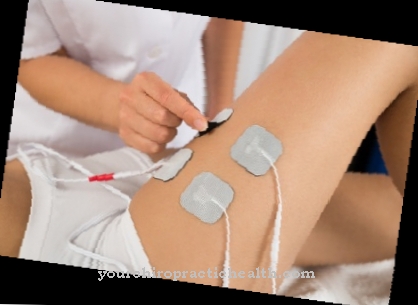The Therapeutic fasting is not religiously motivated and should serve to cleanse and purify the body. There are different types of therapeutic fasting.
What is therapeutic fasting?

Fasting is the complete or partial avoidance of food. You can only fast for a few hours, for several days or even weeks. For many millennia, people have fasted for a variety of reasons. Hippocrates recognized fasting as a medical therapy.
Some people have to fast because of poor harvests or wars. Fasting is also often religiously motivated. However, these motives do not play a role in therapeutic fasting. Therapeutic fasting occurs either for medical reasons or for preventive reasons. Therapeutic fasting is intended to activate the body's self-healing powers, stimulate the body to detoxify and initiate purification. Psychological changes can also be desirable during fasting. The aim is to make it easier for those who are fasting to see inside by avoiding food.
Function, effect & goals
There are different types of therapeutic fasting. What all forms have in common, however, is that they should serve to prevent and alleviate diseases. More and more people are suffering from civilization diseases such as obesity, gastrointestinal diseases, diabetes mellitus or high blood pressure.
Many foods contain preservatives, colorings and flavor enhancers. Supporters of alternative medicine assume that the body stores many of these substances. During the fasting cure, the body should be freed from the deposited toxins. By giving up food, the metabolism is supposed to be relieved, so that the body has more time to eliminate unnecessary things. Discharge procedures such as colon cleansing or detox teas can support the body in this task. The best-known variant of fasting is the tea-juice fast according to Otto Buchinger. The internist Otto Buchinger recognized that complete fasting leads to discomfort for many people.
During the Buchinger fast, vegetable broth, juices and honey are added. A calorie intake of 500 calories per day is not exceeded. This avoids straining the metabolism. At the same time, the body continues to receive important nutrients and vital substances. In addition, enemas are carried out. These are used to clean the colon. Other metabolism-supporting measures such as liver wraps or dry brushing are also part of the Buchinger cure.
Another type of fasting is the Breuss cure. It is used in alternative medicine to accompany cancer treatment. During the Breuss fast, solid food is avoided for 42 days. Fruit juices and herbal teas are allowed. According to Breuss, this should selectively starve the cancer cells. However, the thesis is highly controversial. In the Breuss fasting cure, the less juice you drink a day, the better the cure will be. Breuss also recommends a special juice mix with carrots and beetroot.
A well-known fasting cure is the F.-X.-Mayr cure. The main aim of this fast is to cleanse the intestines. The cure is explicitly not intended to reduce weight. Warm water with Epsom salts is drunk every morning on an empty stomach. This is used to clean the colon. It has a laxative effect. Then light exercise and alternating showers are on the program. A lot of herbal tea and mineral water are drunk during the cure. Clear vegetable broth is also allowed. In the evening a course roll is consumed with milk. The bread roll serves as training for the salivary glands and as a chewing trainer. Only fruits are consumed during fruit fasting. Vegetables, herbs and nuts are also allowed.
On the other hand, no solid foods are used with whey fasting. Instead, a liter of whey, half a liter of orange juice and three liters of still water are given each day. The whey is said to reduce protein loss during fasting. The orange juice is used to supply minerals and vitamins and the mineral water is supposed to promote detoxification. In addition, a glass of sauerkraut juice is drunk every morning to cleanse.
Risks, side effects & dangers
Many doctors are rather skeptical about therapeutic fasting. Healthy people can usually fast for a few days without any problems. However, a doctor should always be consulted before long fasts. Pregnant and breastfeeding women should not fast at all.
Children and people with an increased tendency to bleed should also refrain from fasting. Fasting is also not suitable for people with an overactive thyroid, for people with circulatory disorders in the brain, for type 1 diabetics, for underweight people and for those with eating disorders. People with mental illnesses should only fast after consulting their doctor. If the body does not receive any usable food, the metabolism turns into a catabolic metabolism in the short term. Blood pressure and blood sugar levels drop. In order for the body to get the energy it needs, it breaks down fat and muscle tissue to preserve protein. With longer therapeutic fasting, so-called keto bodies are created during fat loss. These include acetone, 3-hydroxybutyrate, and acetoacet. This condition can develop into ketosis.
In ketosis, there is an excessive amount of ketone bodies in the blood. There is also an increased excretion of ketones in the urine and in the exhaled air. A fruity bad breath is typical of ketosis. The uric acid level also increases due to the catabolic metabolism. This favors the development of kidney and bladder stones. People with gout may have a gout attack due to the increased uric acid levels during fasting.
Fasting can also cause headaches, fatigue, and weakness. Impaired performance and mood swings can also occur. However, the symptoms usually go away completely after a few days. Otherwise, the fast should be stopped immediately.

.jpg)







.jpg)



.jpg)



.jpg)







.jpg)


